From DVD Beaver (posted December 2007). — J.R.
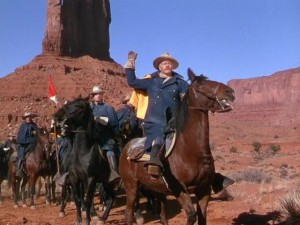
The first John Ford film I can remember seeing, probably encountered around the time I was in first grade, was archetypal: She Wore a Yellow Ribbon (1949). Apart from its uncommonly vibrant colors, this had just about everything a Ford movie was supposed to have: cavalry changes, drunken brawls, Monument Valley, and such standbys as John Wayne, Ben Johnson, Harry Carey Jr., Victor McLaglen, and Ford’s older brother Francis; only Maureen O’Hara and Ward Bond were missing.
Ford was one of the very first auteurs I was aware of, along with Cecil B. De Mille, Walt Disney, and Alfred Hitchcock, and what made him especially distinctive was that he was apparently less restricted than the others to a single genre. De Mille made spectaculars, Disney did cartoons, and Hitchcock specialized in thrillers, but a Ford movie could be a western, a war movie, or something else.
The ten relatively neglected Ford movies I’ve singled out here include a few that still can’t be found on DVD. I might well have selected some others if I’d seen them more recently (I’m currently looking forward to re-seeing the 1945 They Were Expendable, for instance), but I’d none the less argue that all of these are well worth hunting down. Though a few of them are arguably as quintessentially Fordian as She Wore a Yellow Ribbon (and three are honest-to-Pete westerns), most of the others are sufficiently atypical to suggest that Ford is a richer, more complex, and more versatile filmmaker than we usually assume. I’ve also drawn attention in the following remarks to some of the abler Ford commentaries and sources that have helped me find my way through the intricacies of his work.
(NOTE: CLICK ON TITLES, COVERS OR UNDERLINED TEXT FOR LINKS)
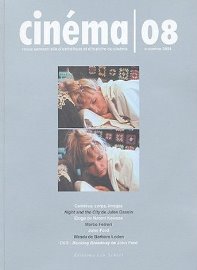
| |
Bucking Broadway (1917). Out of the approximately 70 silent films that Ford directed, less than 15 are currently known to have survived. Bucking Broadway — one of the 11 or 12 westerns he turned out in 1917, the year he started directing — was rediscovered only eight years ago in a Paris film archive, where it was hiding under a different title. (It exists on DVD, but only as a supplement to the “08,” “automne 2004” issue of the excellent, biannual French film journal Cinéma — which has been including DVDs of rare archival finds in every one of its issues since 2003. – available HERE). Not nearly as well known or as ambitious than Ford’s Straight Shooting, which was shot earlier the same year (and was found in a Czech film archive in 1969), Bucking Broadway is none the less delightful for its visual qualities, such as the gorgeous landscape shots at the beginning and the eye-filling action climax in which a team of Wyoming ranchers are seen galloping down Manhattan’s Broadway (actually downtown Los Angeles). |
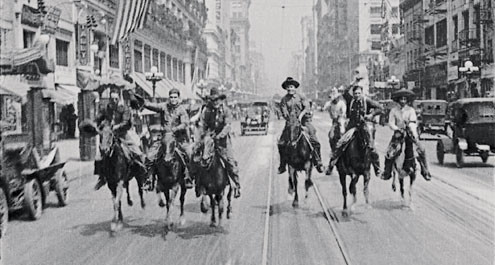 |
| Like Straight Shooting, it stars Harry Carey — a veteran of D.W. Griffith films who was almost twice Ford’s age and served as his mentor when he was getting started, as well as the star of over two dozen of Ford’s early pictures. Mainly a light comedy, it hinges on a romantic rivalry between Cheyenne Harry (a cowboy character Carey played in most of his Ford films) and a villainous city slicker and cattle buyer played by Vester Pegg (another Ford regular at the time) over a rancher’s daughter (still another Ford regular, Molly Malone). |
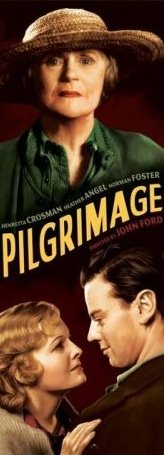 |
| Pilgrimage (1933). For many years, Ford specialists such as Tag Gallagher and Joseph McBride have been singling out this uncharacteristic melodrama as one of the master’s unsung masterpieces, even though it was a big commercial success in 1933, and now that Fox has finally issued a digital restoration, their claims seem wholly justified. In fact, one of the best reasons for seeing the restoration a second time is to follow McBride’s excellent commentary, invaluable both for its factual information and its critical insights. (McBride’s observation that Ford likes to follow tragedy with farce in the same pictures is especially helpful.) What’s most unsettling is the poisonous spin it gives to what is more often one of Ford’s sappiest themes, mother love. The mother in this case, remarkably played by stage actress Henrietta Crosman, is a selfish Arkansas widow and farmer in 1918 who’s so traumatized by the prospect of losing her son to the woman he loves and sleeps with (this is pre-Code) that she spitefully signs him into the army, where he’s instantly killed in World War 1. She even states fairly explicitly in the dialogue that she’d rather see him dead than lose him to another woman, and after he dies, she refuses to recognize either his illegitimate son or his mother. After this excruciating first act, the film unexpectedly turns into a light comedy with occasional dark undertones once the mother reluctantly agrees to join a group of “gold star” mothers on a pilgrimage to their sons’ graves in France. The film then starts to function on a good many registers at once: as a devastating critique of war propaganda, as a satire about yahoo Americans or “innocents abroad” (a theme popularized by Mark Twain in his first best seller), as a complex character study that steadily grows in impact, and as a kind of parable about moral redemption in which the mother finally comes to terms with her own responsibility for her son’s death. |
|
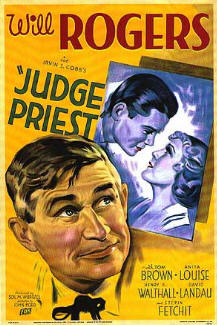 |
|
Judge Priest(1934). “In some ways,” Dave Kehr has written, “Judge Priest marks the birth of the poet in Ford.” There’s certainly no other Ford movie that I know that comes closer to celebrating the idyllic 19th century America of Mark Twain, expressing nostalgia for the snug, leisurely life in closely interknit small-town communities. But for me the real triumphs of this laid-back masterpiece are the performances — especially those of Will Rogers, Stepin Fetchit, and, in the film’s courtroom climax, Henry B. Walthall (the “Little Colonel” of The Birth of a Nation, almost 20 years later.) Rogers, who was something of a national sage when he made this movie, tends to be underrated or at least taken for granted these days, but listen to the amazing job he does in one scene of imitating Stepin Fetchit, and notice how he pulls off the impossible task in another of talking to his dead wife without resorting to the sort of sentimentality you’d expect. (This scene clearly anticipates the more famous one in which Henry Fonda in the title role of Ford’s 1939 Young Mr. Lincoln speaks to Ann Rutledge at her graveside.) |
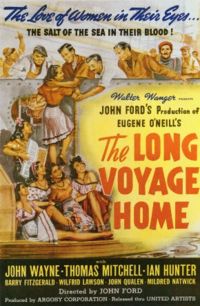 |
The Long Voyage Home (1940). What is it about this moody, lyrical adaptation of four short Eugene O’Neill “sea plays” by Ford regular Dudley Nichols that makes Tag Gallagher and Joseph McBride hurry past it as quickly as possible? Gallagher gives it roughly the same amount of space as Sex Hygiene — a half-hour army training film about venereal diseases that Ford directed the following year — while McBride calls it “extravagantly overwrought,” an epithet I’d rather apply to Ford’s previous The Informer and his later The Fugitive. Maybe because the film was overrated in its own era there’s an impulse to underrate it now, but I’m not buying into this short-sighted rationale for a downgrade. This rambling, melancholy tale about the lonely lives of merchant seamen is certainly expressionistic, and the raw emotions it expresses are unusually direct for Ford. O’Neill himself loved the film, and not because it’s at all faithful to the letter of his work (the action has been updated from the teens to the present), though it’s as doom-ridden and as riddled with despair as one would expect any good O’Neill adaptation to be.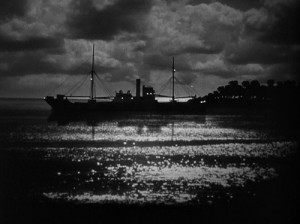 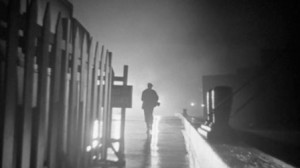 |
|
| (The title anticipates that of his posthumously released, autobiographical masterwork, Long Day’s Journey into Night.) It has the most beautiful deep-focus cinematography by Gregg Toland prior to Citizen Kane; Welles’ own grand gesture of sharing a title card in the credits with Toland came from Ford’s identical gesture in this film, a year earlier. It also has John Wayne’s most interesting performance when he’s playing someone other than himself — as Ole Olsen, a young Swedish sailor who misses his mother, with an accent that sounds authentic. The remainder of the superb ensemble cast includes Thomas Mitchell, Ian Hunter, Barry Fitzgerald, John Qualen, Ward Bond, Wilfred Lawson, Joe Sawyer, and, in her first work for Ford, Mildred Natwick. |
|
|
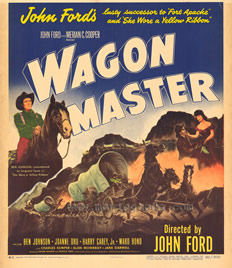
|
Wagon Master (1950). Collectivity is one of Ford’s grandest and
most persistent themes, and it comes to the fore in this small-scale western with no stars than remained one of Ford’s personal favorites. The minimal plot focuses on the various interactions between half a dozen separate groups: ornery outlaws (who kill a bartender out of spite in the pre-credits sequence), horse traders (Ford regulars Harry Carey Jr. and Ben Johnson), traveling Mormons (including a couple of more Ford standbys, Ward Bond and Jane Darwell) who hire the horse traders to help them out, show people (including Joanne Dru and Alan Mowbray), lawmen, and Indians. Furthermore, this may be the closest Ford ever got to making a musical, another form that’s usually collective in spirit; the Sons of the Pioneers — a vocal group that Ford would use again on his next feature, the last and least of his cavalry-trilogy films, Rio Grande — sings no less than four songs, and when cowpokes Carey and Johnson decide to join the Mormons, their decision is expressed by singing the movie’s theme song. |
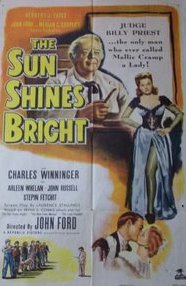 |
|
The Sun Shines Bright (1953). It seems significant that Ford’s favorites among his own films tended to be the artier efforts that did relatively poorly at the box office: The Informer (1935); The Long Voyage Home (1940); The Fugitive (1946 — perhaps the most self-consciously composed of all his pictures); Wagon Master; and the only non-independent feature in the bunch, a belated spin-off of Judge Priest that he made for Republic Pictures, one of the cheaper studios in Hollywood. This time he approaches the Irvin S. Cobb universe without any stars–unless one counts Stepin Fetchit, the only significant actor apart from Francis Ford (in his last credited screen appearance) who appears in both pictures, and a subversive purveyor of southern black stereotypes whose subtly loaded portrayals of servility masking cunning have often been misunderstood.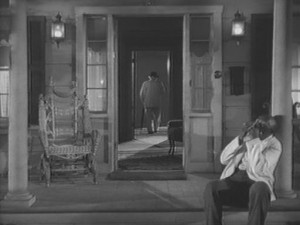 |
| A lot of Ford’s most deeply moving work could be described as a meditation on social rituals, and this masterpiece really comes into its own, despite a rather convoluted plot, in its closing stretches, when it becomes nothing but social rituals—a funeral, an election, and a parade. The funeral and the parade (the latter in tribute to the Judge Priest, played here by Charles Winninger, who has recently officiated at the funeral of a fallen woman), and there’s an almost Faulknerian twist and irony in the way that the funeral becomes triumphant while the celebratory parade becomes almost unbearably sad and tragic. This is one of the Ford films in which farce precedes rather than follows tragedy, but the bittersweet aftertaste is no less pungent. |
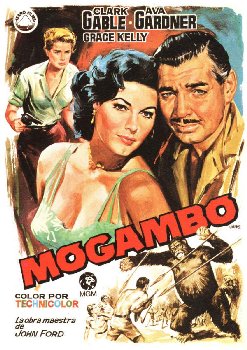 |
| Mogambo (1953). Probably the least characteristic Ford movie in my selection isn’t very satisfying as an African action picture. Ford, who was ill during part of the shooting, left most of the animal footage to his second unit, and the crosscutting between the Hollywood stars (Clark Gable reprising his own role in this remake of the 30s hit Red Dust, Ava Gardner, and Grace Kelly) and the apes or panthers looks pretty artificial. If Hatari! (1962), where the actors and animals share the same shots, can be viewed in many respects as Howard Hawks’ “answer” to Mogambo (much as Leo McCarey’s underrated Good Sam was his own “answer to Frank Capra’s It’s a Wonderful Life), it’s worth adding that Gardner’s showgirl character here is quintessentially Hawksian — both as the outsider we identify with and the outspoken prattler who articulates everything the other main characters are too repressed to blurt out (as well as a maternal figure like Elsa Martinelli in Hatari! who coddles baby elephants). In fact, what mostly makes this movie click is erotic star power triple-distilled. Even more than Hitchcock, Ford, who fought to cast Kelly in this picture, knew how to make her sexy by treating her as a sexually voracious volcano who’s constantly about to erupt and no less constantly in denial about her desire. Here she’s married to an anthropologist on a jungle safari and lusting after animal trapper Gable, while Gardner alternates as romantic rival and as good-natured referee. |
|
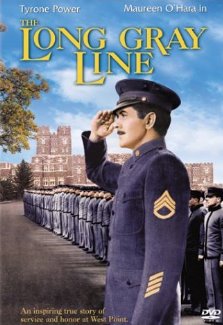
The Long Gray Line (1955). In the recently updated edition of his 1986 book on Ford (which is available only online HERE), Tag Gallagher reports that “The question once came up with Jean-Marie Straub, what is an experimental film? Straub slammed his fist on the table: `The Long Gray Line! That’s an experimental film.’” Well, not exactly — it’s a fictionalized biopic about an Irish-born, not-very-smart-or-especially-capable phys-ed instructor at West Point named Marty Maher (Tyrone Power, playing opposite Maureen O’Hara). It’s also Ford’s first picture in CinemaScope. On one level it’s a patriotic, pro-military sob-fest with corny slapstick that affectionately depicts then-President Dwight D. Eisenhower when he was still a West Point cadet (played, naturally, by Harry Carey Jr.), brimming with the kind of epic schmaltz that Ford has often been faulted for. But it also has the eerie ambivalence of Ford’s richest and most conflicted work, focusing on failure, death, dissolution, and defeat as it’s perceived through an utter mediocrity’s fading memory.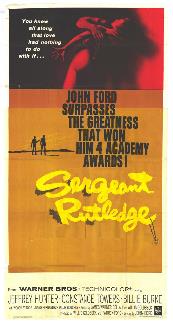 |
|
|
Sergeant Rutledge (1960). Apart from serving as one of the key inspirations and reference points for Pedro Costa’s digital Portuguese masterpiece Colossal Youth (2006), this unusually expressionistic western by Ford — centered on the trial of a black cavalry officer (Woody Strode) accused of rape and murder, and structured around a good many flashbacks — is especially notable for its very theatrical lighting schemes.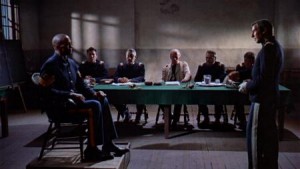
But it’s also potent, above all, because of the rare emotion that Strode brings to the title part. The political incorrectness that seems inextricably tied to some of Ford’s finest insights and moments comes to the fore in Strode’s climactic scene at the trial. Even if some other aspects of this film are labored and formulaic, this is a far more plausible attempt by Ford to deal with ethnic persecution and racism than his lamentable Cheyenne Autumn (1964) — which purports to make amends for Ford’s earlier treatment of Native Americans and then ultimately avoids dealing with them at all by treating them like ersatz Holocaust Jews. |
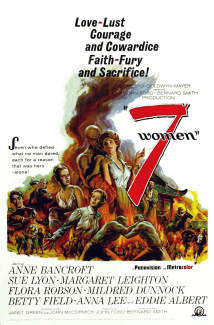
|
7 Women (1965). Patricia Neal was originally cast in the heroic lead role of Ford’s apocalyptic final feature, which uncharacteristically focuses almost entirely on female characters — as an atheistic, hard-drinking, foul-mouthed doctor in a Chinese mission during the 1930s. But she became ill on her third day of shooting, and was quickly replaced by Anne Bancroft, who does a terrific job. Several critics have compared this character to Ava Gardner’s in Mogambo, and the similarity is evident despite the fact that Bancroft plays a dedicated doctor while Gardner plays a flighty showgirl. An unusual film for Ford, it’s also clearly a very personal one about the collapse of civilization and the sacrifices needed for the survival of society. It was a resounding commercial flop because MGM and most audiences didn’t know what to make of it. It’s certainly more of a shocker than any other Ford film I’ve selected, and the less you know about it in advance, the better. 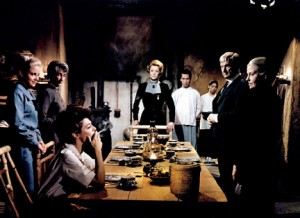 |
In one of the most provocative and original pieces about Ford that I’ve read, by Japanese critic Shigehiko Hasumi HERE, a persuasive, detailed argument is made about the significance of throwing things in Ford’s films, which functions emotionally and thematically (often expressing a character’s solitude) as well as formally. As Hasumi points out, 7 Women ends with a powerful gesture of this kind, and “No other filmmaker has ended his career with such mastery.” But you’ll have to see the movie in order to perceive why and how.

















